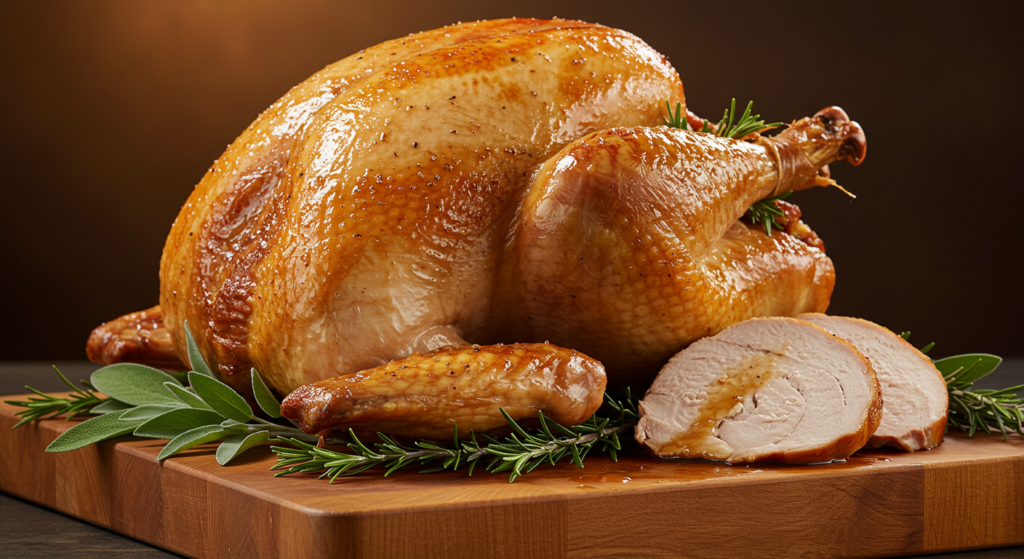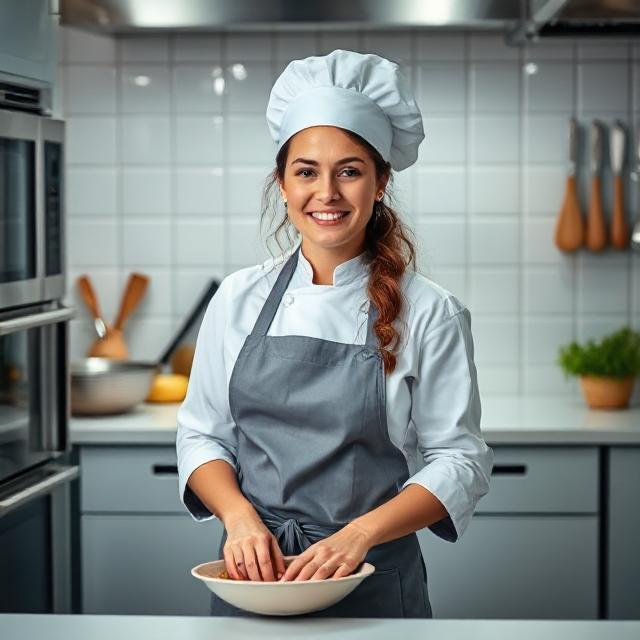Table of Contents
Perfectly Juicy -1-Turkey: Easy & Delicious Recipe
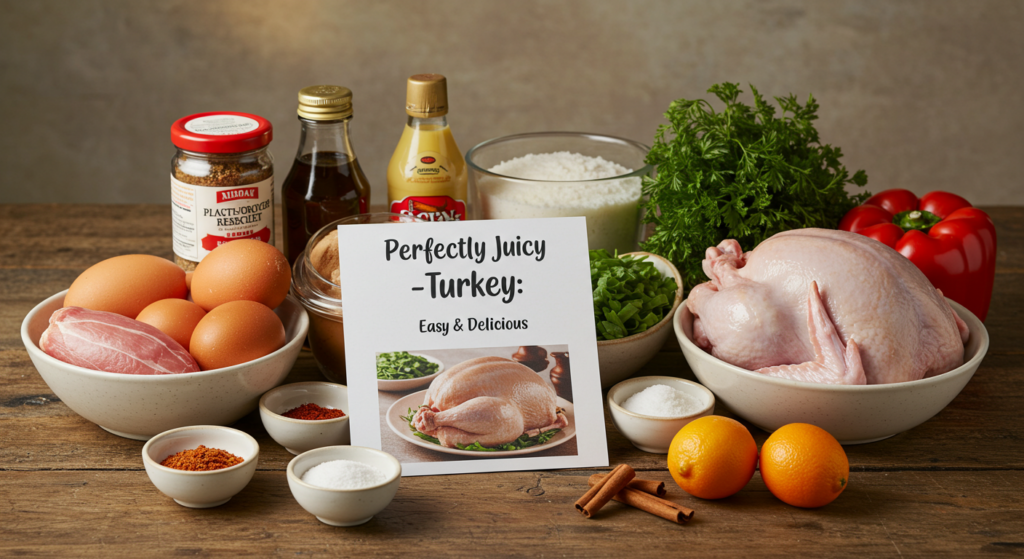
Preparing the perfect turkey can seem daunting. But with the right guidance, anyone can master how to cook a turkey. It becomes the centerpiece of a memorable holiday meal. Baking a turkey requires careful planning, precise techniques, and a dash of culinary confidence.
This comprehensive guide will walk you through every step of creating a mouthwatering turkey. It will impress your family and friends. From selecting the right bird to achieving that golden-brown perfection, we’ll break down the process into simple, manageable steps. This makes baking a turkey an enjoyable cooking experience.
Key Takeaways
- Understanding turkey preparation is crucial for a successful holiday meal
- Proper selection and preparation are key to a delicious turkey
- Cooking techniques can make or break your turkey’s flavor and texture
- Temperature and timing are critical for a perfectly baked turkey
- Fresh ingredients and careful seasoning elevate your turkey from good to extraordinary
- Patience and attention to detail ensure a memorable dining experience
Choosing the Right
Choosing the perfect turkey is key to a memorable Thanksgiving. Your choice can make or break your dinner. So, it’s important to understand your options well.
Understanding Turkey Sizes
The turkey size depends on how many guests you’re hosting. Here’s a quick guide to help you choose:
- 4-6 people: 8-12 pound
- 6-8 people: 12-16 pound
- 8-10 people: 16-20 pound
- 10-12 people: 20-24 pound
Pro tip: Always add an extra pound or two for leftovers and second helpings.
Fresh vs. Frozen: Which Is Best?
The debate between fresh and frozen turkeys matters for Thanksgiving. Fresh have better texture and flavor but cost more. Frozen turkeys are cheaper and easier to find.
Organic and Heritage Turkeys: Worth the Hype?
Organic and heritage turkeys add something special to your Thanksgiving. Heritage breeds have richer flavor and traditional taste. Organic turkeys have fewer pesticides and are raised naturally.
- Heritage turkeys: More expensive, intense flavor
- Organic turkeys: Raised without antibiotics
- Standard turkeys: Most budget-friendly option
Your turkey choice depends on your budget, taste, and cooking skills. Pick wisely for a delicious Thanksgiving feast.
Preparing for Baking
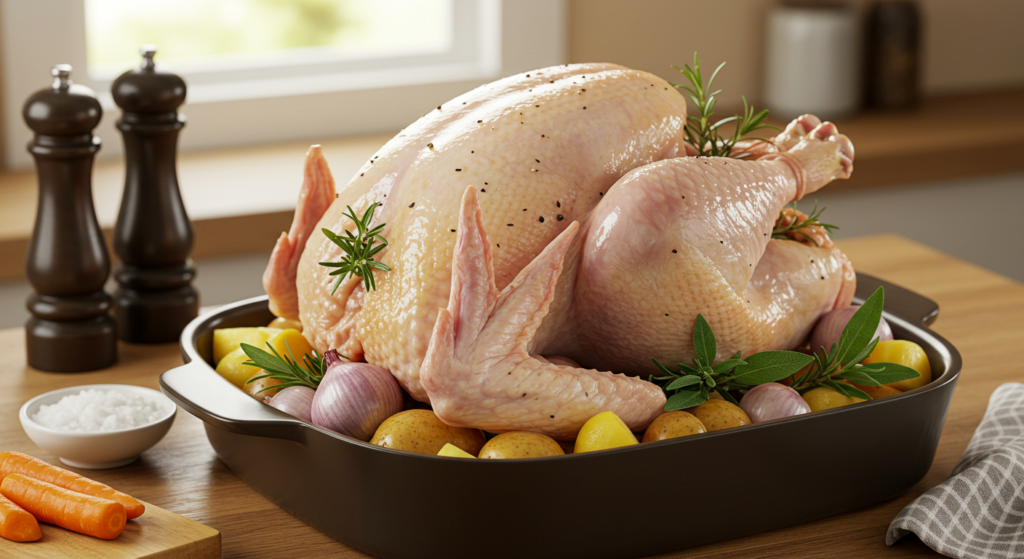
Getting your turkey ready for the oven is key. The right steps can turn an ordinary bird into a delicious centerpiece for your holiday meal. Understanding these steps is crucial for successful turkey cooking.
Defrosting the Turkey Properly
Safe defrosting is vital to avoid foodborne illness and ensure even cooking. Here are some guidelines for defrosting your turkey:
- Refrigerator method: Allow 24 hours of thawing for every 4-5 pounds of turkey
- Cold water method: Submerge the turkey in cold water, changing water every 30 minutes
- Never defrost turkey at room temperature
Brining: Is It Necessary?
Brining can make a big difference in your turkey. This technique involves soaking the bird in a saltwater solution to enhance moisture and flavor. While not mandatory, brining offers significant benefits:
- Increases meat tenderness
- Improves overall flavor
- Helps prevent dry meat during cooking
Seasoning Options to Consider
Elevate your turkey with creative seasoning techniques. From classic herb blends to innovative spice rubs, the right seasoning can transform your turkey into a culinary masterpiece. Consider these flavor-boosting options for your best turkey recipes:
- Traditional herb mix with rosemary, thyme, and sage
- Citrus and garlic rub
- Smoky paprika and pepper blend
- Mediterranean-inspired herb combination
Pro turkey cooking tips suggest letting seasonings sit on the bird for several hours before cooking to maximize flavor penetration.
Essential Tools for Baking
Getting a delicious turkey ready for your holiday cooking guide needs more than just cooking skills. The right kitchen tools can make your turkey roasting tips go from good to great. Both professional chefs and home cooks say quality equipment is key to getting that perfect golden-brown bird.
The Right Roasting Pan
Finding the perfect roasting pan is key for turkey success. Look for these important features:
- Sturdy construction with heavy-gauge metal
- Handles for easy maneuvering
- Rack included for air circulation
- Size appropriate for your turkey weight
Cooking Thermometers: A Must-Have Tool
When roasting a turkey, precision is crucial. A reliable meat thermometer is essential for safety and accuracy. Digital instant-read thermometers give quick, precise temperature readings to avoid overcooking or undercooking.
Kitchen Essentials You Can’t Skip
Tools beyond the roasting pan and thermometer will also improve your turkey roasting tips:
- Sharp carving knife
- Basting brush
- Kitchen twine for trussing
- Large cutting board
- Aluminum foil for tenting
Investing in quality kitchen tools can turn your holiday cooking guide into a pro-level experience. With the right tools, you’ll confidently cook a turkey that’s the star of your festive meal.
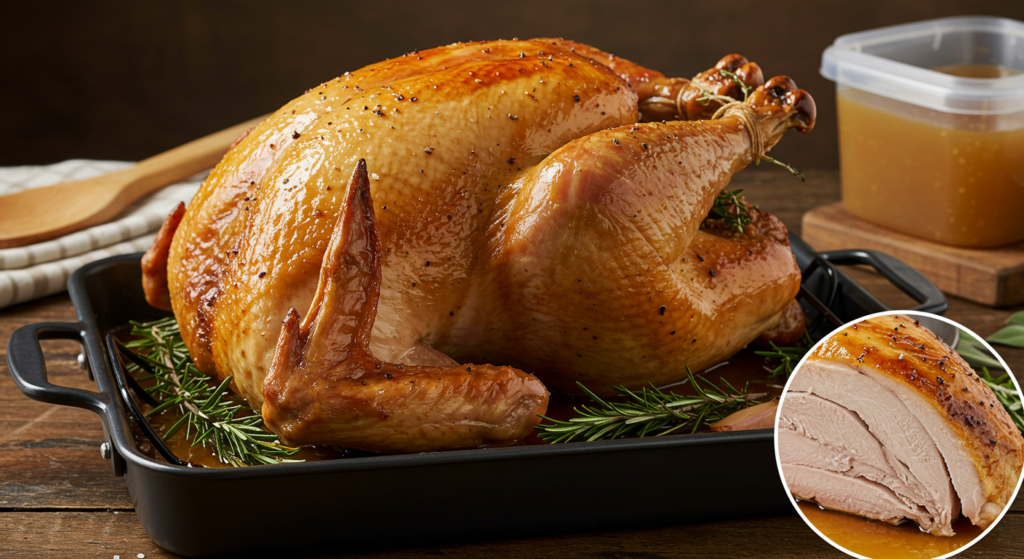
Oven Preparation
Getting your oven ready is key to a tasty roast turkey. The right steps can turn a simple bake into a feast that wows your guests.
Preheating Your Oven Correctly
Start with the basics for a great roast turkey. Preheat your oven to 325°F (165°C). This ensures your turkey cooks evenly and turns out golden brown.
- Set oven rack in the lowest position
- Remove any extra racks to create space
- Preheat for at least 20 minutes before cooking
Convection vs. Conventional Heat
Knowing your oven’s heat options is important. Convection ovens cook more evenly and can save time. Traditional ovens work well too, but might need some tweaks.
Cooking Times Based on Turkey Weight
Cooking time depends on your turkey’s size. Here’s a quick guide:
| Turkey Weight | Approximate Cooking Time |
|---|---|
| 8-12 pounds | 2.75-3 hours |
| 12-14 pounds | 3-3.75 hours |
| 14-18 pounds | 3.75-4.25 hours |
Always check your turkey’s temperature with a meat thermometer. It should be 165°F (74°C) at the thickest part of the thigh.
Baking Techniques: The Perfect Roast
Learning how to cook a turkey is all about mastering key baking techniques. These techniques turn an ordinary bird into a culinary masterpiece. The right approach can make all the difference between a dry, tough meal and a succulent, flavorful centerpiece.
The Ideal Temperature for Roasting
Turkey cooking tips start with temperature control. Most experts recommend roasting at 325°F (163°C) for consistent, even cooking. This temperature allows the turkey to cook thoroughly without burning the exterior.
- Preheat the oven completely before placing the turkey inside
- Use an oven thermometer to verify accurate temperature
- Avoid frequent oven door opening to maintain consistent heat
Aluminum Foil: To Tent or Not to Tent
Aluminum foil can be a game-changer in turkey preparation. Loosely tenting the turkey prevents excessive browning while helping retain moisture during the cooking process.
“The key is a loose tent – not a tight wrap that traps steam and makes skin soggy.” – Professional Chef
Basting Techniques
Basting remains a controversial turkey cooking tip. While traditional methods suggest frequent basting, many modern chefs argue it can interrupt cooking and create uneven temperatures.
- If basting, use pan drippings or melted butter
- Limit basting to every 45-60 minutes
- Consider using a dry brining method instead
Remember, patience and precision are your best tools when learning how to cook a turkey that will impress your guests.
Flavor Boosters for Your Turkey
Make your Thanksgiving dinner unforgettable by learning how to add flavor. The right mix of herbs, liquids, and stuffing can turn your turkey into a masterpiece. It’s all about enhancing the taste in the best turkey recipes.
Fresh Herbs: Nature’s Flavor Enhancers
Fresh herbs are key to a memorable Thanksgiving turkey. Choose herbs that match your turkey’s taste:
- Rosemary: Provides a robust, earthy flavor
- Thyme: Offers a subtle, delicate taste
- Sage: Delivers a classic Thanksgiving aroma
- Parsley: Adds a fresh, bright note
Liquid Flavor Infusions
The right liquid can change your turkey’s taste. Here are some great options for your Thanksgiving dinner ideas:
| Liquid | Flavor Profile | Best Used For |
|---|---|---|
| White Wine | Crisp and light | Delicate turkey preparations |
| Chicken Broth | Rich and savory | Traditional roasting methods |
| Dark Beer | Deep and complex | Robust flavor enhancement |
Stuffing: Flavor Without Overwhelming
Creating the perfect stuffing is all about balance. Less is more when filling your turkey. Choose high-quality ingredients that enhance the meat’s flavor without being too heavy.
- Use fresh ingredients
- Keep seasoning balanced
- Avoid overstuffing
- Consider herbs that match your liquid base
By picking the right herbs, liquid, and stuffing, you’ll make a turkey that steals the show. It will be the highlight of your Thanksgiving dinner.
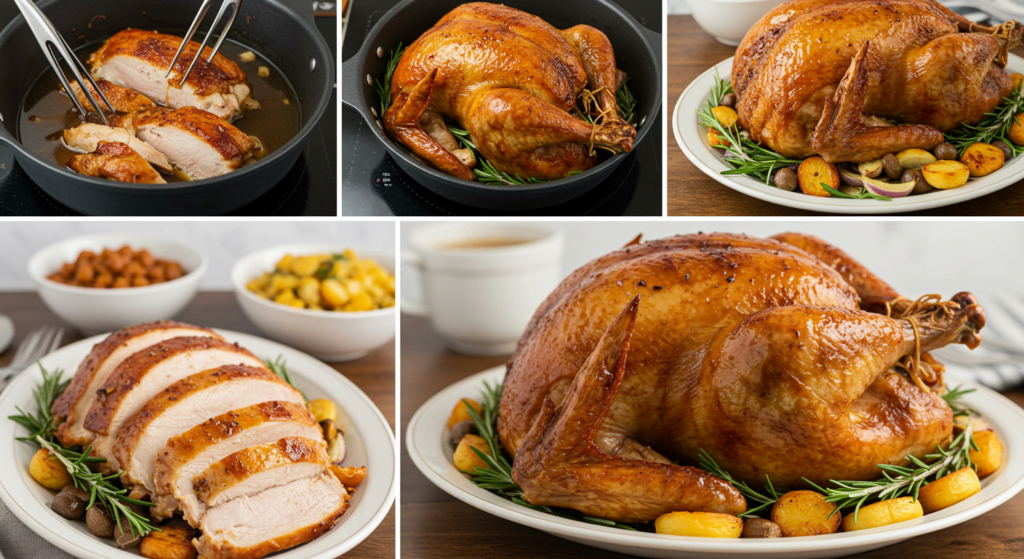
When to Start Baking
Getting the timing right for your Thanksgiving turkey is key. It’s all about planning and timing to make a delicious turkey. This turkey will be the star of your holiday meal.
When cooking a turkey for a big gathering, timing is everything. Several factors can affect your turkey’s success. These factors are crucial for your Thanksgiving feast.
Planning Your Cooking Schedule
Here are important timing tips for your turkey:
- Calculate approximately 15-20 minutes of cooking time per pound of turkey
- Factor in defrosting time for frozen turkeys (24 hours per 4-5 pounds)
- Allow extra time for large gatherings and multiple dishes
Understanding Resting Time After Roasting
The resting time is often missed but it’s very important. Chefs say to let your turkey rest for 20-30 minutes after it’s done.
“Patience transforms a good turkey into a great one.” – Professional Chef Recommendation
Resting helps the juices spread evenly. This makes each slice tender and full of flavor. It also makes carving easier.
Timing Tips for Seamless Meal Preparation
- Start thawing frozen turkeys 3-4 days before Thanksgiving
- Prep side dishes while turkey is cooking
- Use a meat thermometer to check internal temperature
By following these tips, you’ll have a stress-free and tasty Thanksgiving meal. Your guests will be impressed, and cooking will be fun.
Checking for Doneness
Mastering turkey roasting tips means knowing when your bird is perfectly cooked. Food safety and taste depend on checking for doneness. It’s important to understand both temperature and visual signs of a perfectly roasted turkey.
The best way to check turkey doneness is with a meat thermometer. This tool is key to avoiding undercooked meat and foodborne illnesses.
Understanding Internal Temperature Guidelines
Internal temperature is the key to turkey cooking. Here are the important temperature checks:
- Breast meat: 165°F (74°C)
- Thigh meat: 175°F (79°C)
- Wing meat: 165°F (74°C)
Put the meat thermometer into the thickest part of the meat, away from bones. Always check multiple areas to ensure consistent cooking throughout the turkey.
Visual Cues to Look For
While temperature is key, visual signs can help too:
- Skin should be golden brown and crispy
- Juices running from the meat should be clear, not pink
- Meat should easily separate from the bone
Let the turkey rest for 15-20 minutes after cooking. This makes the meat moist and flavorful, ensuring it’s perfectly cooked from edge to center.
Carving Your Baked
Learning to carve a turkey can make your Thanksgiving dinner stand out. A well-carved turkey not only looks great but also ensures everyone gets the best meat.
Expert Carving Techniques
Carving a turkey needs precision and the right tools. Before starting, make sure you have these:
- Sharp carving knife
- Large cutting board
- Serving platter
- Meat fork
Step-by-Step Carving Instructions
Here’s how to carve your turkey like a pro:
- Let the turkey rest for 20-30 minutes after roasting
- Remove the legs by cutting through the joint connecting them to the body
- Separate the thighs from the drumsticks
- Slice breast meat against the grain in thin, even cuts
- Remove wings by cutting through the shoulder joint
Presentation Tips for the Perfect Platter
Make your turkey the centerpiece with these tips:
| Placement Technique | Visual Impact |
|---|---|
| Arrange dark and white meat separately | Creates organized, appetizing display |
| Use fresh herb garnishes | Adds color and aromatic appeal |
| Position meat on a warm platter | Keeps carved turkey at optimal serving temperature |
Pro tip: Slice meat against the grain for tenderness and easy eating.
Leftover Turkey Ideas
After a tasty Thanksgiving meal, leftover turkey can shine in new dishes. Easy Thanksgiving recipes show you how to make the most of it. Your kitchen turns into a place of endless possibilities, from sandwiches to casseroles.
Storing turkey right is key. It keeps fresh for days, letting you make more meals. Store it in airtight containers in the fridge within two hours. This keeps it safe and tasty.
Try turkey salad, pot pies, or soups for a tasty reuse. Shredded turkey is great in quesadillas, enchiladas, and pasta. Remember, slice or chop it before storing to make prep quicker.
Leftover turkey is a blank canvas for your taste buds. It can be comfort food or something new. With a little creativity, your leftovers can be just as exciting as the original meal.
FAQ
How big of a turkey should I buy for my Thanksgiving dinner?
Plan for 1 to 1.5 pounds of turkey per person. This ensures everyone gets a good serving and there’s some left over. For 8-10 people, get a 12-15 pound turkey. Remember, the bone adds weight, and consider how hungry your guests will be.
Is it better to buy a fresh or frozen ?
Both have their perks. Fresh turkeys taste better and don’t need long thawing. Frozen turkeys are cheaper and can be bought early. If you choose frozen, thaw it in the fridge for 24 hours for every 4-5 pounds.
How long does it take to thaw a frozen turkey?
Thawing in the fridge is safest. For a 15-pound turkey, it takes 3-4 days. Never thaw at room temperature, as it can lead to bacterial growth.
What’s the recommended internal temperature for a fully cooked ?
The turkey must reach 165°F (74°C). Use a meat thermometer in the thickest parts of the thigh, wing, and breast. Make sure you’re not measuring bone, as it can give a wrong reading.
Should I brine my turkey before cooking?
Brining makes the turkey moist and flavorful. You can wet brine or dry brine. Dry brining is quicker and easier if you’re short on time or fridge space.
How long should I cook it?
Cooking time varies by turkey weight and oven temperature. Roast at 325°F for about 15 minutes per pound for an unstuffed turkey. A 15-pound turkey cooks in 3-3.75 hours. Always check with a meat thermometer to ensure it’s done.
Can I stuff the turkey before baking?
Stuffing inside the turkey can make it cook longer and might be unsafe. It’s safer to cook stuffing in a casserole. If you stuff the turkey, make sure the stuffing reaches 165°F to avoid bacterial growth.
How long can I keep leftovers?
Keep leftovers in the fridge within two hours of cooking. They stay safe for 3-4 days in airtight containers. You can freeze turkey for up to 4 months. Always reheat leftovers to 165°F before eating.
Do I need to baste my turkey while cooking?
Basting is optional. It can make the skin golden, but opening the oven often can dry out the turkey. Many chefs prefer a butter or herb rub before cooking for a crispy skin.
What’s the best way to keep my turkey moist?
To keep the turkey moist, brine it beforehand, don’t overcook, and use a meat thermometer. Let it rest after cooking and cover with foil if the skin browns too fast. Basting with pan juices or butter also helps.
Perfectly Juicy-1-Turkey: Easy & Delicious Recipe
Description
This Perfectly Juicy Turkey recipe ensures a tender, flavorful bird that's golden-brown and succulent. With a blend of aromatic herbs and a simple butter rub, it's the perfect way to impress your guests. Whether you're a seasoned chef or a first-time turkey baker, this recipe is easy to follow and guarantees a holiday feast to remember.
Perfectly Juicy Turkey: Easy & Delicious Recipe
🦃 Main Ingredients
🌿 Herb Butter (for flavor & moisture)
🧅 Aromatics (for stuffing the cavity)
🧂 Dry Brine (if not using wet brine) – Optional
Nutrition Facts
Servings 10
- Amount Per Serving
- Calories 330kcal
- % Daily Value *
- Total Fat 20g31%
- Saturated Fat 6g30%
- Cholesterol 130mg44%
- Sodium 130mg6%
- Potassium 250mg8%
- Total Carbohydrate 350g117%
- Protein 39g78%
- Vitamin A 400 IU
- Vitamin C 3 mg
- Calcium 20 mg
- Iron 2 mg
* Percent Daily Values are based on a 2,000 calorie diet. Your daily value may be higher or lower depending on your calorie needs.
Note
Rest your turkey after roasting for 20–30 minutes to ensure juicy meat. Always check internal temperature with a thermometer to guarantee the bird is fully cooked.

